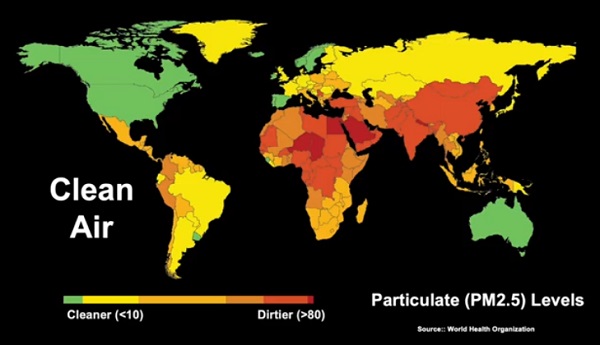Environment
Official Temperature Data Aren’t ‘Data’ and Shouldn’t Be Used to Restrict Freedom

From Heartland Daily News
It is becoming increasingly clear that the temperature data the U.S. government and many other governments use to predict catastrophic climate change, the data from surface temperature stations, aren’t accurate.
To paraphrase Elizabeth Barrett Browning’s Sonnet 43: How bad is the surface station record? Let me count the flaws.
Even its climate alarmist defenders acknowledge that surface station data runs too hot. To make matters worse for the alarmist cause, the overheated surface station data are still lower than what climate models say the temperatures should be based on the amount of carbon dioxide in the atmosphere. This fact strongly suggests the assumed climate sensitivity to a doubling of atmospheric carbon dioxide of pre-industrial levels built into models is also way too high.
Further evidence that the surface station data are flawed stems from the fact that the surface station readings do not match the temperatures recorded by global satellites and weather balloons, two alternative temperature sources whose data sets closely track each other.
The Heartland Institute has exposed instances in both the United States and abroad wherein official agencies tamper with past temperature data at pristine stations. Not only have these agencies been caught adjusting records to appear cooler than what was actually recorded, they have also manipulated temperatures upward, making the recent warming trend appear steeper and more severe than it actually is.
I’ve written extensively about the so-called adjustments made by corrupt NOAA scientists in 2015, just before the Paris climate treaty negotiations – mixing data from unbiased ocean buoys with heat-biased temperature measurements taken from ships’ engine water intake inlets, which made it appear as if the ocean was suddenly warming faster than before. More recent research claiming the oceans were heating up fast, seeming to confirm NOAA’s manipulated ocean claims, had to be corrected for overstating ocean warming or risk being withdrawn from publication.
My colleague, award-winning meteorologist Anthony Watts, working with a team of volunteers, independently documented serious problems with the official surface temperature record arising from the fact that the vast majority of temperature stations are poorly sited. In fact, these stations routinely fail to meet NOAA’s own standards for quality, which results in temperatures being skewed upward due to the Urban Heat Island (UHI) effect.
In 2009, and again in 2022, Watts detailed with station location data and photographic evidence just how woefully ill-sited these surface stations truly are. Stations providing official data were frequently sited in locations where surrounding surfaces, structures, and equipment radiated stored heat or emitted heat directly biased and drove the recorded temperatures higher than were recorded at stations in the same region that were uncompromised by the well-known UHI effect that is widely ignored by alarmists and official government agencies. Watts’ 2009 paper determined that 89 percent of the stations failed to meet the National Weather Service’s own siting requirements.
The media and government bureaucrats took notice of Watts’ findings, the latter producing official responses that admitted the problem, while declaring the temperature record, despite the gross violation of established rules for sound temperature data collection, was still valid and reliable.
Even while claiming “no harm, no foul,” the U.S. government shuttered some of the most egregiously sited stations highlighted in Watts’ report and established an alternative temperature network, the U.S. Climate Reference Network (USCRN), consisting of new stations with state-of-the-art equipment sited in locations unlikely to ever be impacted by the UHI effect. The temperature data set from the USCRN, for anyone who cares, displays about half the warming and a slower rate of warming than the broader U.S. Historical Climate Network (USHCN) used by the government in its official reports claiming unprecedented warming. In fact, the data from the relatively few well-sited, unbiased USHCN stations, when compared to the network as a whole, also show half the warming reported by the government. The government has accurate data, it just doesn’t report or count it as official.
Simultaneously, the government added thousands of previously uncounted temperature stations maintained by various agencies and private parties to the official network – existing stations added without any quality control protocols.
The result of the latter effort was predictably disastrous from the perspective of producing a high quality, trustworthy record of surface temperatures uninfluenced by the UHI effect. Unfortunately, Watts’ 2022 report found that the situation has become even worse. Watts and his team of volunteers discovered that 96 percent of the stations surveyed in the NOAA’s expanded network failed its own quality control standards for siting, resulting in an UHI bias in the temperatures they report.
Now, an investigative report by Katie Spence, a journalist at The Epoch Times, exposes an additional problem with the U.S. surface temperature record – a failing arguably more egregious than the issues I’ve discussed so far: many “stations” allegedly “reporting” temperatures don’t actually exist anymore, and haven’t for years. The government is just making up the data reported from many locations based on an averaging of temperatures recorded at other locations in the area.
And it’s not just a few missing stations providing made-up numbers, pointed out Lt. Col. John Shewchuk, a certified consulting meteorologist, who was interviewed by Spence for the story.
“NOAA fabricates temperature data for more than 30 percent of the 1,218 USHCN reporting stations that no longer exist,” Shewchuk told Spence. “They are physically gone – but still report data – like magic.”
To this day, NOAA still relies upon temperature “data” from the ghost stations, with an “E” for estimate.
Watts was consulted for the story as well, explaining to The Epoch Times that, “[i]f this kind of process were used in a court of law, then the evidence would be thrown out as being polluted.”
While the surface data may be the best source we have, when it is as biased or even fabricated as it is increasingly found to be, there is no way it should be used to drive public policies limiting the freedom of billions of people in their personal and economic affairs, all in the vain hope of controlling the weather in the future.
H. Sterling Burnett, Ph.D., ([email protected]) is the director of the Arthur B. Robinson Center on Climate and Environmental Policy at The Heartland Institute, a non-partisan, non-profit research organization based in Arlington Heights, Illinois.
Energy
Affordable Energy: Everything you need to know about energy and the environment

The Dual Challenge: Energy and Environment
Scott Tinker
The world faces two important and interrelated challenges. Affordable and reliable energy for all, and protecting the environment. The energy-environment challenge is not simple, but it is solvable if we understand and address the complex fabric of energy security, scale of energy demand, physics of energy density, distribution of energy resources, interconnectedness of the land, air, water and atmosphere, and the extreme disparity in global wealth and economic health. The truth is that there are no good and bad, clean and dirty, renewable and nonrenewable energy sources. They all have benefits, and they all have challenges. Climate change is an important issue, but it is not the only environmental issue. Solar and wind are important low carbon solutions, but they are only part of the solution. We must put our best minds to the task of addressing the dual challenge, working together to better the world.
Economy
Canadian Natural Gas Exports Could Significantly Reduce Global Emissions

From the Fraser Institute
By Elmira Aliakbari and Julio Mejía
Doubling Canadian natural gas production and exporting to Asia could reduce global emissions by up to 630 million tonnes—nearly as much as Canada produces in a year
Canada could help significantly reduce global greenhouse gas emissions by increasing natural gas production and exporting the additional supply to Asia in the form of liquefied natural gas (LNG), according to a new study from the Fraser Institute, an independent, non-partisan Canadian public policy think tank.
“As countries like China and India continue to burn coal for power, Canadian LNG offers a lower-emission alternative with the potential for major global impact,” said Elmira Aliakbari, director of natural resource studies at the Fraser Institute and coauthor of the study, Exporting Canadian LNG to the World: A Practical Solution for Reducing GHG Emissions
The study estimates the impact from Canada doubling its natural gas production and exporting to Asia to replace coal-fired power. In that scenario, global emissions could drop up to 630 million tonnes annually, which is the equivalent of removing approximately 137 million cars from the road. More specifically, replacing coal-fired power in China with Canadian LNG could cut emissions by up to 62 per cent for every unit of power produced.
“Focusing only on domestic emissions ignores Canada’s potential to support global climate goals,” said Aliakbari. “By displacing coal abroad, Canadian LNG can play a critical role in cutting total global emissions even if domestic emissions were to increase.”
However, regulatory uncertainty and a range of federal and provincial policies continue to hinder LNG development in Canada, despite strong global demand.
“Policymakers need to clear a path if Canada is going to play a meaningful role in reducing global emissions,” Aliakbari added.

Exporting Canadian LNG to the World: A Practical Solution for Reducing GHG Emissions
- Coal, a major source of greenhouse gas (GHG) emissions, remains a leading energy source in many Asian countries, especially China and India. Some European countries have also turned back to coal as sanctions on Russian energy intensified following the invasion of Ukraine.
- As the world seeks practical solutions for reducing greenhouse-gas emissions, natural gas, with its lower carbon footprint, offers a promising alternative to coal.
- With abundant reserve, Canada is well positioned to help reduce global reliance on coal. By exporting Canadian liquified natural gas (LNG) and helping Asian and European countries reduce their reliance on coal, Canada can lower net global GHG emissions.
- Exporting LNG from Canada to China and substituting LNG for coal in the generation of power there can eliminate between 291 and 687 gCO₂eq per kWh of power generated, a reduction of between 34% and 62%.
- If Canada were to double its current natural gas production and export the additional supply to Asia as LNG to displace an equivalent amount of coal used to generate power, global GHG emissions could be reduced by up to 630 million tonnes annually, a significant reduction equivalent to 89% of Canada’s total GHG emissions.
- Canada enjoys several competitive advantages, including cooler temperatures that reduce liquefaction energy costs and a strategic location that offers shorter shipping routes to Europe and Asia compared to many other suppliers.
- Regulatory challenges and a mix of federal and provincial policies, however, have slowed or blocked LNG developments in Canada.
-

 National2 days ago
National2 days agoCarney promotes MP instrumental in freezing Freedom Convoy donors’ bank accounts
-

 Business2 days ago
Business2 days agoThe carbon tax’s last stand – and what comes after
-

 conflict24 hours ago
conflict24 hours agoIran nuclear talks were ‘coordinated deception’ between US and Israel: report
-

 illegal immigration1 day ago
illegal immigration1 day agoLA protests continue as judge pulls back CA National Guard ahead of ‘No Kings Day’
-

 conflict2 days ago
conflict2 days agoIsrael strikes Iran, targeting nuclear sites; U.S. not involved in attack
-

 International1 day ago
International1 day agoIsrael’s Decapitation Strike on Iran Reverberates Across Global Flashpoints
-

 Energy1 day ago
Energy1 day agoCanada is no energy superpower
-

 Alberta1 day ago
Alberta1 day agoPunishing Alberta Oil Production: The Divisive Effect of Policies For Carney’s “Decarbonized Oil”





